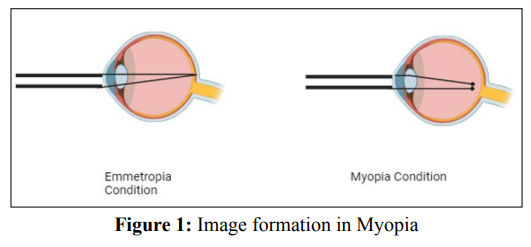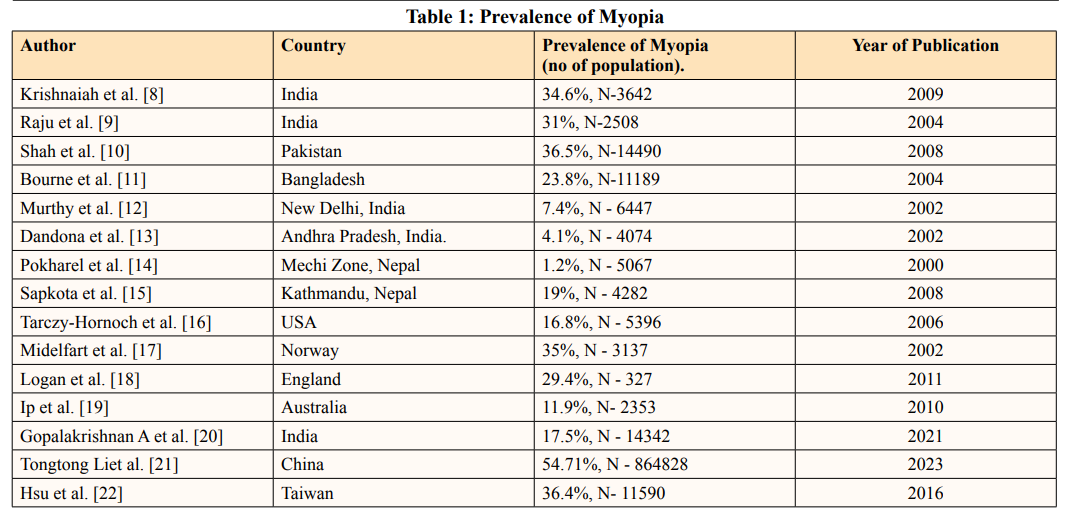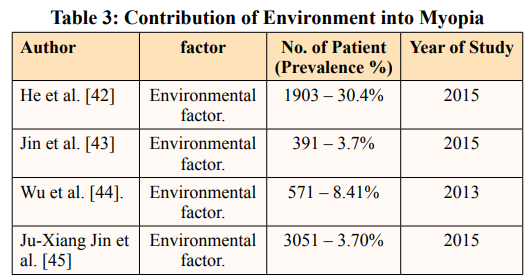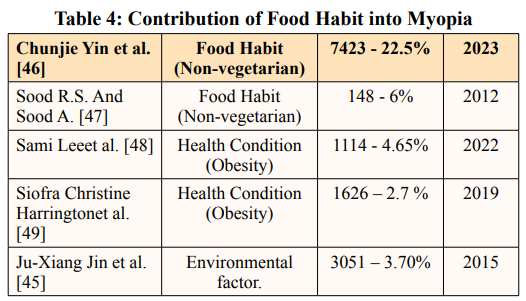Author(s): Arbaz, Raj Kumar* and Rajeev Trivedi
Myopia is a refractive error in which a distance object looks blurry. It happens when the light is focused in front of the retina. It is increasing day by day. There are estimates indicating that by 2050, approximately half of the global population might develop myopia, and roughly 10% could experience high levels of myopia. The incidence of myopia varies geographically; changes in lifestyle and urbanization have an impact on its prevalence. Myopia may be more common in urban areas due to restricted access to outdoor activity, especially in East and Southeast Asia. Environmental, lifestyle, and genetic factors interact in a complex way to influence myopia. Here ditary factors are important; the probability of developing myopia is increased if parents have the condition. Another important factor in the development of myopia is the environment. Reading and other prolonged, intense near work activities, like screen time; have been linked to a higher risk of myopia. Understanding the complex nature of myopia is crucial. This article will review the factors causing myopia and the relative significance or weighting of various factors in the development of myopia.
Myopia is also known as near-sightedness, in which a distance object looks blurry. It happens when the light is focused in front of the retina (Figure 1). It is occurring when there is a mismatch or abnormality in the way the various optical components of the eye work together to focus light onto the retina, the key optical components involved in this process are the cornea, the crystalline lens, and the eye’s axial length (AL). There are two types of myopia Physiological and Pathological myopia. A correlation failure of the refraction components in a normal eye leads to physiological myopia. Excessive axial elongation mainly affecting the posterior pole and ora-equatorial area is the cause of pathologic myopia. Ophthalmoscopy evidence of this process includes the formation of posterior staphylomas and changes to the peripheral fundus. Ocular refraction is primarily determined by heredity, although a variety of factors can cause both transient and permanent myopias [1]. The most prevalent eye condition globally is myopia [2]. There are estimates indicating that by 2050, approximately 50% of the global population might develop myopia, and roughly 10% could experience high levels of myopia [3]. Over the past few decades, multiple studies have found valuable insight into the prevalence patterns and the factors that cause the development of myopia. From 1972 to 2004, there has been a significant rise in the prevalence of myopia in the United States, with the percentage increasing from 25% to 44% [4,5]. The prevalence of myopia is different in different countries; it is dependent on the rural environment and the urban environment (Table 1). In Asian urban areas, myopia prevalence exceeds 80% [6]. In underdeveloped regions like Sherpa in Nepal, the prevalence of myopia is lower [7]. There are many factors that cause myopia; hereditary and environmental factors are the two main causes. There have been few studies that have employed a longitudinal approach to thoroughly investigate the development of myopia with careful observation, and these studies have offered valuable insights into the potential causes of myopia, or the number of factors involved in the occurrence of myopia.


Parental Myopia: Numerous studies have investigated the relationship between a parent’s myopia and the likelihood that their child will also develop myopia [23,24,25], Children who have one myopic parent (OR = 1.87) or two myopic parents (OR = 2.40) are statistically significantly more likely to develop myopia, according to a new meta-analysis of 16 studies examining the relationship between parental myopia and juvenile myopia [26]. People with one or both myopic parents are at an increased risk of developing myopia themselves, as the condition tends to run in families (Table2). Research is still ongoing to determine which specific genetic variables affect myopia.

Environmental Factor: Environmental variables can have a crucial impact on the development and progression of myopia. Among these elements are:


In the past, some eye care specialists have held the opinion that myopia is an inherited abnormality, while others have held the opinion that environmental factors cause myopia. However, research done on humans and animals over the past 40 years indicates that both genetic and environmental factors play a role in the development of myopia [50]. Children who have one myopic parent (OR = 1.87) or two myopic parents (OR = 2.40) are statistically significantly more likely to develop myopia, according to a recent meta-analysis of 16 studies examining the relationship between parental myopia and juvenile myopia [51]. Ocular axial elongation has been associated with multiple genetic loci [52]. Research on the human population indicates that genetic factors contribute to at least 70% of the variation in refraction [53]. It is evident that having myopia in both parents raises the likelihood of developing myopia [54]. Spending more time outside has been demonstrated to be protective against the development of incident myopia [55]. When compared to control eyes, spending 76 minutes a day outside reduced the incidence of myopia by 50%, according to the study’s dose-response analysis [56]. Myopia more common in urban areas as compared to rural area in India [57]. According to a recent meta-analysis review of 25 papers examining the connection between myopia and outdoor time, spending more time outside protected against myopia but had no effect on the rate at which myopia developed in eyes that were already myopic. Some studies find a link between time spent on near tasks and the development of Myopia [58,59]. SAVES and X-PRES are two studies that did not find any link between the amount of time spent on near tasks and the development of myopia [60,61]. We need more surveys and studies to analyse the contributing factors to childhood myopia. More research is necessary to fully understand the intricate relationship that exists between a person’s genetic makeup, behavioural patterns, and risk factors for myopic progression in patients. It was unclear if there is an interaction between these factors or if they operate independently. We need more research to determine which specific genetic variables affect myopia. We need to find out the possible processes that underlie the benefits of spending time outside to control myopia. We need more research to find out the connection between eating habits and myopia. Till now, more research has been done to control myopia progression, but we need to control the development of myopia and find the interaction between these factors, or whether they operate independently. These are all the requirements needed to control the development of myopia, its progression, and reduce its prevention until 2050.
Myopia is primarily caused by two factors: genetics and the environment (Reading and other prolonged, intense near work activities, like screen time, have been linked to a higher risk of myopia). Myopia more common in urban areas with restricted access to outdoor areas, especially in East and Southeast Asia, the incidence of myopia varies geographically; changes in lifestyle and urbanization have an impact on its prevalence. Till now, more research has been done to control myopia progression, but we need to control the development of myopia and find the interaction between these factors, or whether they operate independently.
1.Curtin B J (1979) Physiologic vs pathologic myopia: genetics vs environment. Ophthalmology 86: 681-691.
2.Pararajasegaram R (1999) VISION 2020-the right to sight: from strategies to action. American journal of ophthalmology 128: 359-360.
3.Holden B A, Fricke T R, Wilson D A, Jong M, Naidoo K S, et al. (2016) Global Prevalence of Myopia and High Myopia and Temporal Trends from 2000 through 2050. Ophthalmology 123: 1036-1042.
4.Kempen J H, Mitchell P, Lee K E, Tielsch J M, et al. (1960) Eye Diseases Prevalence Research Group (2004). The prevalence of refractive errors among adults in the United States, Western Europe, and Australia. Archives of ophthalmology (Chicago, Ill) 122: 495-505.
5.Vitale S, Sperduto R D, Ferris F L (2009) Increased prevalence of myopia in the United States between 1971-1972 and 1999- 2004. Archives of ophthalmology (Chicago, Ill) 127: 1632- 1639.
6.Lin L L, Shih Y F, Hsiao C K, Chen C J (2004) Prevalence of myopia in Taiwanese schoolchildren: 1983 to 2000. Annals of the Academy of Medicine, Singapore 33: 27-33.
7.Niroula D R, Saha C G (2009) Study on the refractive errors of school going children of Pokhara city in Nepal. Kathmandu University medical journal (KUMJ) 7: 67-72.
8.Krishnaiah S, Srinivas M, Khanna R C, Rao G N (2009) Prevalence and risk factors for refractive errors in the South Indian adult population: The Andhra Pradesh Eye disease study. Clinical ophthalmology (Auckland, N.Z.) 3: 17-27.
9.Raju P, Ramesh S V, Arvind H, George R, Baskaran M, et al. (2004) Prevalence of refractive errors in a rural South Indian population. Investigative ophthalmology & visual science 45: 4268-4272.
10.Shah S P, Jadoon M Z, Dineen B, Bourne R R, Johnson G J, et al. (2008) Refractive errors in the adult pakistani population: the national blindness and visual impairment survey. Ophthalmic epidemiology 15: 183-190.
11.Bourne R R, Dineen B P, Huq D M, Ali S M, Johnson G J (2004) Correction of refractive error in the adult population of Bangladesh: meeting the unmet need. Investigative ophthalmology & visual science 45: 410-417.
12.Murthy G V, Gupta S K, Ellwein L B, Muñoz S R, Pokharel G P, et al. (2002) Refractive error in children in an urban population in New Delhi. Investigative ophthalmology & visual science 43: 623-631.
13.Dandona R, Dandona L, Srinivas M, Giridhar P, McCarty C A, et al. (2002) Population-based assessment of refractive error in India: the Andhra Pradesh eye disease study. Clinical & experimental ophthalmology 30: 84-93.
14.Pokharel G P, Negrel A D, Munoz S R, Ellwein L B (2000) Refractive Error Study in Children: results from Mechi Zone, Nepal. American journal of ophthalmology 129: 436-444.
15.Sapkota Y D, Adhikari B N, Pokharel G P, Poudyal B K, Ellwein L B (2008) The prevalence of visual impairment in school children of upper-middle socioeconomic status in Kathmandu. Ophthalmic epidemiology 15: 17-23.
16.Tarczy-Hornoch K, Ying-Lai M, Varma R (2006) Los Angeles Latino Eye Study Group Myopic refractive error in adult Latinos: the Los Angeles Latino Eye Study. Investigative ophthalmology & visual science 47: 1845-1852.
17.Midelfart A, Kinge B, Midelfart S, Lydersen S (2002) Prevalence of refractive errors in young and middle-aged adults in Norway. Acta ophthalmologica Scandinavica 80: 501-505.
18.Logan N S, Shah P, Rudnicka A R, Gilmartin B, Owen C G (2011) Childhood ethnic differences in ametropia and ocular biometry: the Aston Eye Study. Ophthalmic & physiological optics: the journal of the British College of Ophthalmic Opticians (Optometrists) 31: 550-558.
19.Ip J M, Saw S M, Rose K A, Morgan I G, Kifley A, et al. (2008) Role of near work in myopia: findings in a sample of Australian school children. Investigative ophthalmology & visual science 49: 2903-2910.
20.Gopalakrishnan A, Hussaindeen J R, Sivaraman V, Swaminathan M, Wong Y, et al. (2022) Prevalence of myopia among urban and suburban school children in Tamil Nadu, South India: findings from the Sankara Nethralaya Tamil Nadu Essilor Myopia (STEM) Study. Ophthalmic & physiological optics: the journal of the British College of Ophthalmic Opticians (Optometrists) 42: 345-357.
21.Li T, Wei R, Du B, Wu Q, Yan J, et al. (2023) Prevalence of myopia among children and adolescents aged 6-16 during COVID-19 pandemic: a large-scale cross-sectional study in Tianjin, China. The British journal of ophthalmology bjo- 2023-323688. Advance online publication.
22.Hsu C C, Huang N, Lin P Y, Fang S Y, Tsai D C, et al. (2017) Risk factors for myopia progression in second-grade primary school children in Taipei: a population-based cohort study. The British journal of ophthalmology 101: 1611-1617.
23.Jones-Jordan L A, Sinnott L T, Manny R E, Cotter S A, Kleinstein R N, et al. (2010) Collaborative Longitudinal Evaluation of Ethnicity and Refractive Error (CLEERE) Study Group. Early childhood refractive error and parental history of myopia as predictors of myopia. Investigative ophthalmology & visual science 51: 115-121.
24.Pacella R, McLellan J, Grice K, Del Bono EA, Wiggs J L, et al. (1999) Role of genetic factors in the etiology of juvenile- onset myopia based on a longitudinal study of refractive error. Optometry and vision science: official publication of the American Academy of Optometry 76: 381-386.
25.Kurtz D, Hyman L, Gwiazda J E, Manny R, Dong L M, et al. (2007) Role of parental myopia in the progression of myopia and its interaction with treatment in COMET children. Investigative ophthalmology & visual science 48: 62-570.
26.Zhang X, Qu X, Zhou X (2015) Association between parental myopia and the risk of myopia in a child. Experimental and therapeutic medicine 9: 2420-2428.
27.Guggenheim J A, Pong-Wong R, Haley C S, Gazzard G, Saw S M (2007) Correlations in refractive errors between siblings in the Singapore Cohort Study of Risk factors for Myopia. The British journal of ophthalmology 91: 781-784.
28.Wojciechowski R, Congdon N, Bowie H, Munoz B, Gilbert D, et al. (2005) Heritability of refractive error and familial aggregation of myopia in an elderly American population. Investigative ophthalmology & visual science 46: 1588-1592.
29.Framingham Offspring Eye Study Group (1996) Familial aggregation and prevalence of myopia in the Framingham Offspring Eye Study. Archives of ophthalmology 114: 326- 332.
30.Fotouhi A, Etemadi A, Hashemi H, Zeraati H, Bailey-Wilson J E, et al. (2007) Familial aggregation of myopia in the Tehran eye study: estimation of the sibling and parent offspring recurrence risk ratios. The British journal of ophthalmology 91: 1440-1444.
31.Zadnik K, Satariano WA, Mutti DO, Sholtz R I, Adams AJ (1994) The effect of parental history of myopia on children’s eye size. JAMA 271: 1323-1327.
32.Iribarren R, Balsa A, Armesto A, Chiaradia P, Despontín L, et al. (2005) Family history of myopia is not related to the final amount of refractive error in low and moderate myopia. Clinical & experimental ophthalmology 33: 274-278.
33.Sherwin JC, Reacher MH, Keogh RH, Khawaja AP, Mackey DA, et al. (2012) The association between time spent outdoors and myopia in children and adolescents: a systematic review and meta-analysis. Ophthalmology 119: 2141-2151.
34.Li X, Wu M, Zhang L, Liu H, Zhang L, et al. (2017) Riboflavin and ultraviolet A irradiation for the prevention of progressive myopia in a guinea pig model. Experimental eye research 165: 1-6.
35.Saw SM, Hong RZ, Zhang MZ, Fu ZF, Ye M, et al. (2001) Near-work activity and myopia in rural and urban schoolchildren in China. Journal of pediatric ophthalmology and strabismus 38: 149-155.
36.Mutti DO, Mitchell GL, Moeschberger ML, Jones LA, Zadnik K (2002) Parental myopia, near work, school achievement, and children’s refractive error. Investigative ophthalmology & visual science 43: 3633-3640.
37.Lu B, Congdon N, Liu X, Choi K, Lam DS, et al. (2009). Associations between near work, outdoor activity, and myopia among adolescent students in rural China: The Xichang Pediatric Refractive Error Study report no. 2. Archives of ophthalmology 127: 769-775.
38.Enthoven CA, Tideman JWL, Polling JR, Yang Huang J, Raat H, et al. (2020) The impact of computer uses on myopia development in childhood: The Generation R study. Preventive medicine 132: 105988.
39.Reid Chassiakos YL, Radesky J, Christakis D, Moreno MA, Cross C, et al. (2016) Children and Adolescents and Digital Media. Pediatrics 138: e20162593.
40.Rucker FJ, Wallman J (2012) Chicks use changes in luminance and chromatic contrast as indicators of the sign of defocus. Journal of vision 12: 23-23.
41.Jones-Jordan LA, Sinnott LT, Chu RH, Cotter SA, Kleinstein RN, et al. (2021) Myopia Progression as a Function of Sex, Age, and Ethnicity. Investigative Ophthalmology & visual science 62: 36.
42.He M, Xiang F, Zeng Y, Mai J, Chen Q, et al. (2015) Effect of Time Spent Outdoors at School on the Development of Myopia Among Children in China: A Randomized Clinical Trial. JAMA 314: 1142-1148.
43.Jin JX, Hua WJ, Jiang X, Wu XY, Yang JW, et al. (2015) Effect of outdoor activity on myopia onset and progression in school-aged children in northeast China: the Sujiatun Eye Care Study. BMC ophthalmology 15: 73.
44.Wu PC, Tsai CL, Wu HL, Yang YH, Kuo HK (2013) Outdoor activity during class recess reduces myopia onset and progression in school children. Ophthalmology 120: 1080-1085.
45.Jin JX, Hua WJ, Jiang X, Wu XY, Yang JW, et al. (2015) Effect of outdoor activity on myopia onset and progression in school-aged children in northeast China: the Sujiatun Eye Care Study. BMC ophthalmology 15: 73.
46.Yin C, Gan Q, Xu P, Yang T, Xu J, et al. (2023) Dietary Patterns and Associations with Myopia in Chinese Children. Nutrients 15: 1946.
47.Sood RS (2012) The prevalence of myopia Vis-à-Vis the type of diet in young adults. IJBAMS 2: 205-209.
48.Lee S, Lee HJ, Lee KG, Kim J (2022) Obesity and high myopia in children and adolescents: Korea National Health and Nutrition Examination Survey. PloS one 17: e0265317.
49.Harrington SC, Stack J, O’Dwyer V (2019) Risk factors associated with myopia in schoolchildren in Ireland. The British journal of ophthalmology 103: 1803-1809.
50.Wojciechowski R (2011) Nature and nurture: the complex genetics of myopia and refractive error. Clinical genetics 79: 301-320.
51.Zhang X, Qu X, Zhou X (2015) Association between parental myopia and the risk of myopia in a child. Experimental and therapeutic medicine 9: 2420-2428.
52.Wojciechowski R (2011). Nature and nurture: the complex genetics of myopia and refractive error. Clinical genetics 79: 301-320.
53.Lyhne N, Sjølie A K, Kyvik K O, Green A (2001) The importance of genes and environment for ocular refraction and its determiners: a population-based study among 20–45-year- old twins. The British journal of ophthalmology 85: 1470- 1476.
54.Pan C W, Ramamurthy D, Saw S M (2012) Worldwide prevalence and risk factors for myopia. Ophthalmic & physiological optics: the journal of the British College of Ophthalmic Opticians (Optometrists) 32: 3-16.
55.Sherwin J C, Reacher M H, Keogh R H, Khawaja A P, Mackey D A, et al. (2012) The association between time spent outdoors and myopia in children and adolescents: a systematic review and meta-analysis. Ophthalmology 119: 2141-2151.
56.Xiong S, Sankaridurg P, Naduvilath T, Zang J, Zou H, et al. (2017) Time spent in outdoor activities in relation to myopia prevention and control: a meta-analysis and systematic review. Acta ophthalmologica 95: 551-566.
57.Gupta D, Rajkumar L B (2022) Myopia: A School Eye Survey in Rural and Urban Area of Faridabad, Haryana 12: 2249- 9571.
58.You Q S, Wu L J, Duan J L, Luo Y X, Liu L J, et al. (2012) Factors associated with myopia in school children in China: the Beijing childhood eye study. PloS one 7: e52668.
59.French A N, Morgan I G, Mitchell P, Rose K A (2013) Risk factors for incident myopia in Australian schoolchildren: the Sydney adolescent vascular and eye study. Ophthalmology 120: 2100-2108.
60.French A N, Morgan I G, Mitchell P, Rose K A (2013) Risk factors for incident myopia in Australian schoolchildren: the Sydney adolescent vascular and eye study. Ophthalmology 120: 2100-2108.
61.Lin Z, Vasudevan B, Jhanji V, Mao G Y, Gao T Y, et al. (2014) Near work, outdoor activity, and their association with refractive error. Optometry and vision science: official publication of the American Academy of Optometry 91: 376-382.
View PDF